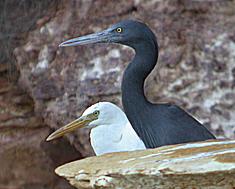Egret
|
|
| Egrets | ||||||||||
|---|---|---|---|---|---|---|---|---|---|---|
 Eastern Reef Egrets | ||||||||||
| Scientific classification | ||||||||||
| ||||||||||
| Genera | ||||||||||
|
Egretta |
An egret is any of several herons, most of which are white or buff, and several of which develop fine plumes during the breeding season. Many egrets are members of the genera Egretta or Ardea which contain other species regarded as herons rather than egrets. The distinction between a heron and an egret is rather vague and depends more on appearance than biology.
Several of the egrets have been moved around from one genus to another in recent years: the Great Egret, for example, was traditionally classified as a member of Egretta, moved to Ardea, and then moved back again. Common names are often a more reliable guide to egret identification.
In the 19th and early part of the 20th century, most of the world's egret species were brought to the brink of extinction by relentless hunting. Hat makers in Europe and the United States demanded massive numbers of egret plumes and breeding birds were massacred in locations all around the world.
The Eastern Reef Egret of the Pacific Ocean shores (illustrated above right) is unusual in that it has two distinct phases: Eastern Reef Egrets are either entirely charcoal-grey or entirely white.
FAMILY Ardeidae
- (many other members not regarded as egrets)
- Great Egret or Great White Egret, Ardea alba
- Intermediate Egret, Ardea intermedia
- Swinhoe's Egret, Ardea eulophotes
- Cattle Egret, Ardea ibis
- Little Egret Egretta garzetta
- Eastern Reef Egret, Egretta sacra
- Western Reef Egret, Egretta gularis
- Snowy Egret, Egretta thula
- Reddish Egret, Egretta rufescens
- Slaty Egret, Egretta vinaceigula
- Chinese Egret, Egretta eulophoteszh:白鹭属

